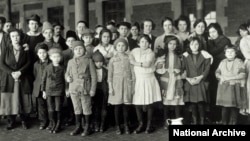When a 12-year-old boy traveled to the United States from Poland, looking for his mother in New York City, he was put into detention. The unaccompanied minor, Chain Shlome Kleinman, was slated to be deported unless the U.S. government found his relatives and verified his information.
Kleinman made the journey in 1907 as a stowaway. When he arrived at the Ellis Island port of entry in New York harbor, he said he had relatives in the U.S. but did not know their addresses.
"He claimed that he was escaping violence at home. He had an abusive father and he was a Jewish boy from the Russian empire, which at the time was discriminating against Jewish people and instituting pogroms," Molly Thacker, a doctoral student in Georgetown University's history department, told VOA.
Kleinman's story, Thacker said, has many similarities to those of the thousands of unaccompanied minors who have come from Central America to the U.S. in recent years. Like them, he was escaping hardship at home.
According to an article that Thacker found in The New York Times' archives that was published September 14, 1907, the 12-year-old boy previously lived in Warsaw. His father forced him to work in a slate mine from 7 a.m. to 8 p.m., "with only a few minutes at noon to eat the scanty luncheon his father provided."
Ambivalence
Thacker started her research in 2014 after reading newspaper articles about the influx of unaccompanied minors from Central America under the Obama administration.
"I was reading reports about how the children were kept ... I was wondering how we have treated these children before," she said.
As the research progressed, Thacker realized there were not many studies on unaccompanied minor immigrants available.
"I think children in general are pretty overlooked by historians and academics," she said, but there has been "very little research done" on unaccompanied children in particular.
She also saw that the language used in describing today's immigration situation is similar to that used in the past.
"On one hand, there is this rhetoric of, 'These children are flooding our country, bearing down the gates,' ... but on the other hand, there's still a strong trend of defending these children, and this story in particular was portrayed as, 'This is the kind of America that we want — somebody who's going to fight into our country and is going to, against all odds, try to get here to become an American,' " she said.
Send them back
Ellis Island operated for 62 years, with 1907 being the port of entry's peak year, when 1,004,756 immigrants arrived. Ellis Island officials had a rigorous send-them-back policy toward unaccompanied minors coming to the U.S.
Thacker said the Immigration Act of 1907 declared that children younger than 16 were not permitted to enter the country without parents.
The measure, however, did not say the children must be deported. It said "children under 16 unaccompanied by either parent ... shall be held for special inquiry."
The act set up a system in which unaccompanied children, many of whom were orphans, were held in detention and had to await the result of a special inquiry with immigration inspectors, who would then determine the youngsters' future in the new world.
At that time, Thacker said, private citizens, as well as local organizations such as synagogues and immigrant aid societies, would begin a campaign to find children's relatives. Some would even offer to become an unaccompanied minor's guardian.
Helping children, then and now
More than a hundred years after Kleinman's arrival, unaccompanied immigrant children are following a similar trajectory.
Mark Hetfield, president and chief executive officer of HIAS, a nonprofit organization that provides humanitarian aid and assistance to refugees, told VOA the stories of minors' journeys then and now are "very, very similar."
HIAS, founded in 1881, assisted many unaccompanied minors fleeing pogroms in Russia and Eastern Europe.
"We've done [this work] since the end of the 19th century, when kids would be sent sometimes alone to Ellis Island. And we advocated for the Wagner-Rogers Bill in the late '30s to bring over Jewish refugee kids from Nazi Germany. But as you know, that went nowhere," Hetfield said.
The Wagner-Rogers Bill was proposed U.S. legislation that would have increased the quota of immigrants. It was expected to allow a total of 20,000 Jewish children younger than 14 into the United States from Nazi Germany.
Currently, Hetfield said the organization is on the list of service providers for children, including unaccompanied minors, in Maryland and New York. The group provides free services to the youngsters who have traveled without an adult.
In the 1900s, Hetfield said, unaccompanied minors could end up in places such as the Hebrew Orphan Asylum in New York.
"So that was quite common. … [Today] a significant number, if not a majority, at least a significant number are reunited with relatives. Maybe not their parents, but with relatives who take over their care," Hetfield said.
Chain, too, was reunited with his mother and uncle after their names were published in a newspaper and they responded.












